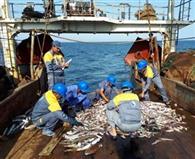
The marine operations for the project of biomass estimation and ecology investigation of benthic organisms in the Persian Gulf and the Oman Sea
Description: The marine operations for the project of biomass estimation and ecology investigation of benthic organisms in the Persian Gulf and the Oman Sea began on October 17 in Chabahar
Text: The ceremony for the initiation of marine operations for the project of stock assessment and biomass estimation of benthic organisms in the Persian Gulf and the Oman Sea with an emphasis on the estimation of aquatic organisms reserves and ecological parameters was held with the presence of academic members and experts of the Iranian Fisheries Science and Research Institute and subsidiary centers and the technical and operational staff of Ferdos 1 research vessel on October 17 at the Hafte Tir wharf of Chabahar port. It should be noted that the project has been approved as one of the priorities of the research programs of the Iranian Fisheries Science and Research Institute. Its main objectives are to evaluate and monitor the stocks of benthic organisms and determine its relationship with bio-ecological and non-bio ecological parameters of water and sediment. This project will be completed within 3 years in the waters of Persian Gulf and Oman Sea in the depths of 10 to 100 meters deep from Khur – Gwadar bay in the east to Khur - Musa bay in the west with the participation of 50 academic members, researchers and experts from the subsidiary research centers of the Iranian Fisheries Science and Research Institute, the South of Iran Aquaculture Research Center- Ahwaz, the Shrimp Research Institute of Iran- Bushehr, the Persian Gulf and Oman Sea Ecological Research Institute- Bandar Abbas and the Chabahar Research Center of the High Seas. In this project, 300 stations are considered for sampling from benthic organisms through bottom trawling and swept area method and 50 stations are considered for sampling of biological parameters (communities of benthic and planktonic invertebrates) and non- biological parameters (including physical and chemical parameters, nutrients, petroleum hydrocarbons and heavy metals) in water and sediment using oceanographic equipments such as the Closing net, Bongo net, Grab, Rutner and CTD.
Sunday 28 Oct 2018
Author: Public relations of the Iranian Fisheries Science and Research Institute
Visit Count:534